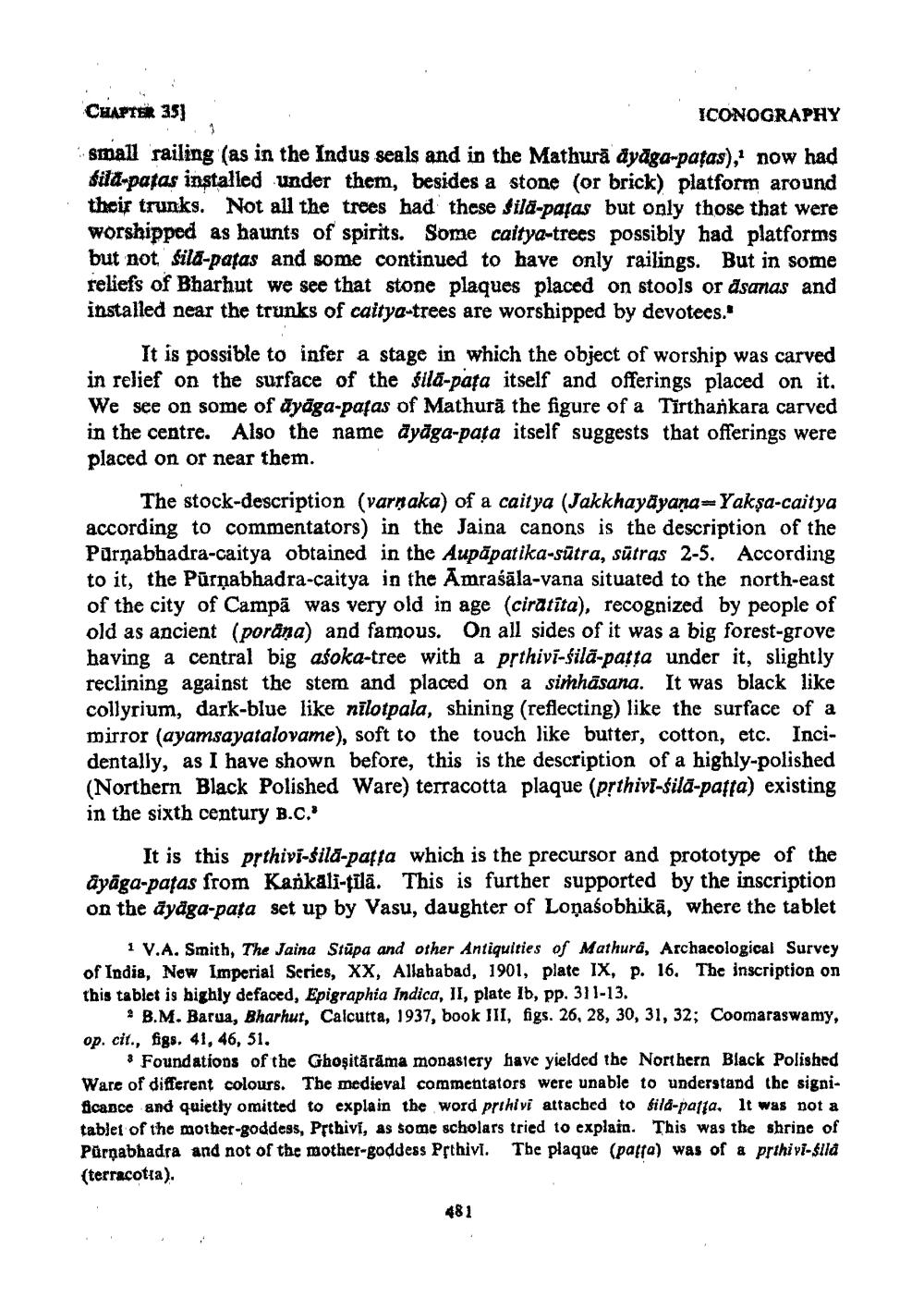________________
CHAPTER 35]
ICONOGRAPHY
3
small railing (as in the Indus seals and in the Mathura dyaga-patas), now had sila-patas installed under them, besides a stone (or brick) platform around their trunks. Not all the trees had these fild-patas but only those that were worshipped as haunts of spirits. Some caitya-trees possibly had platforms but not sila-patas and some continued to have only railings. But in some reliefs of Bharhut we see that stone plaques placed on stools or asanas and installed near the trunks of caitya-trees are worshipped by devotees."
It is possible to infer a stage in which the object of worship was carved in relief on the surface of the fila-pata itself and offerings placed on it. We see on some of ayaga-patas of Mathura the figure of a Tirthankara carved in the centre. Also the name ayaga-pata itself suggests that offerings were placed on or near them.
The stock-description (varnaka) of a caitya (Jakkhayāyaṇa-Yakṣa-caitya according to commentators) in the Jaina canons is the description of the Purṇabhadra-caitya obtained in the Aupapatika-sūtra, sūtras 2-5. According to it, the Pūrṇabhadra-caitya in the Amraśāla-vana situated to the north-east of the city of Campå was very old in age (ciratīta), recognized by people of old as ancient (porana) and famous. On all sides of it was a big forest-grove having a central big aśoka-tree with a prthivi-silä-patta under it, slightly reclining against the stem and placed on a simhasana. It was black like collyrium, dark-blue like nilotpala, shining (reflecting) like the surface of a mirror (ayamsayatalovame), soft to the touch like butter, cotton, etc. Incidentally, as I have shown before, this is the description of a highly-polished (Northern Black Polished Ware) terracotta plaque (prthivi-silä-paffa) existing in the sixth century B.C.'
It is this prthivi-sila-patta which is the precursor and prototype of the ayaga-patas from Kankali-tilä. This is further supported by the inscription on the ayaga-pata set up by Vasu, daughter of Lonasobhika, where the tablet
1 V.A. Smith, The Jaina Stupa and other Antiquities of Mathurd, Archaeological Survey of India, New Imperial Series, XX, Allahabad, 1901, plate IX, p. 16. The inscription on this tablet is highly defaced, Epigraphia Indica, II, plate Ib, pp. 311-13.
B.M. Barua, Bharhut, Calcutta, 1937, book III, figs. 26, 28, 30, 31, 32; Coomaraswamy, op. cit., figs. 41, 46, 51.
* Foundations of the Ghoşitäräma monastery have yielded the Northern Black Polished Ware of different colours. The medieval commentators were unable to understand the significance and quietly omitted to explain the word prthivi attached to fila-patta. It was not a tablet of the mother-goddess, Prthivi, as some scholars tried to explain. This was the shrine of Pūrṇabhadra and not of the mother-goddess Prthivi. The plaque (patta) was of a prthivi-silā
(terracotta).
481




